- Details
- Written by Gordon Prentice
The Clock Tower Hearing at the Superior Court in Newmarket, due to come up tomorrow, Wednesday 15 November 2017, at 11am, is off. It has now been rescheduled - for the fourth time - to 14 May 2018. 
On 3 November 2017, the Town's counsel, Leo Longo of Bay Street lawyers Aird and Berlis LLP, requested a postponement for reasons which are still unclear to me. Papers were originally filed with the Court on 14 June 2017.
The Town wanted a declaration from the Superior Court that a land swap agreement it entered into in 2003 with the then Main Street property owner, Michael Bryan, is binding on Bryan's successor in title, Bob Forrest's Main Street Clock Inc.
Spanner in the works
If the Town succeeds it throws a spanner in the works leaving Bob with a development, as currently drawn, that is impossible to build.
It still puzzles me why the Town's counsel didn't ask the OMB to throw out the Forrest application without a hearing.
But that's yesterday's story. Today I want to know why the Town sought to postpone, yet again, the hearing of the application.
We know that Leo Longo was in discussions with Bob's counsel, Ira Kagan, about getting a suitable date that would work for both of them. On 7 July 2017 Longo emailed Kagan to confirm that
"...due to counsel availability, the return date for the hearing of this matter (Corporation of the Town of Newmarket v Main Street Clock inc) has been moved from October 20, 2017 to November 15, 2017 at 9.30am. The time allotted for the hearing of this matter is three hours."
The new date of 14 May 2018 is perilously close to the new start date of the OMB Clock Tower Hearing, set for 7 August 2018. If the Court hearing goes ahead on 14 May the Judge will hear legal argument and then deliver his or her ruling, perhaps a month or two later.
Army of people
In the meantime and at great expense, a small army of people will be preparing for the OMB hearing on the Clock Tower which will be critically influenced, one way or the other, by the Judge's ruling on who owns the land in Market Square.
This glacial timetable works for the lawyers but what about the public interest?
What about the boarded up and decaying heritage buildings in Main Street?
What about the traders and business people who depend upon a lively and busy downtown?
We are all being failed by a creaking system, not fit-for-purpose, where massive delays are par for the course.
We shouldn't accept this with a shrug of the shoulders as being inevitable.
I don't.
This email address is being protected from spambots. You need JavaScript enabled to view it.
Update 16 November 2017: I asked Esther Armchuk, Newmarket's former Town Solicitor and now Commissioner of Corporate Services, why the Town had sought a postponement. She helpfully told me yesterday:
"The hearing, originally scheduled for today, was adjourned on consent of the lawyers for both parties. Additional time is required to complete the exchange of evidentiary documents, schedule cross examinations on affidavits and argue the matter before Court. The Court had only scheduled 3 hours today for the hearing of this matter, and both parties require more time.
The Newmarket Superior Court has scheduled the matter to be held during the three week long motion/trial session that commences May 14, 2018. At some point during that three week period, the lawyers for the Town and for Main Street Clock Inc. will be given notice by the Superior Court trial office to attend the following day to argue the matter. When that occurs, we will post the hearing date information to the Town's website for the Clock Tower matter. Staff will advise Members of Council and update the website as soon as the new date for this matter has been set."
I am grateful for the explanation but it still doesn't satisfy. Members of the public can expect 24 hours notice of when Newmarket v Main Street Inc is going to come up before a real, live Judge. And why is the whole thing taking so long? Why couldn't the lawyers have sorted out the exchange of evidentiary documents and schedule cross examinations on affidavits by now? They've had months already. I hate to think what the bill will be like when Leo Longo eventually presents it to the Town.
- Details
- Written by Gordon Prentice
The Redwood on Yonge development (on the old Slessor Square site at 17645 Yonge Street) sailed through its Statutory public meeting last week (6 November 2017) without a single comment from local residents. 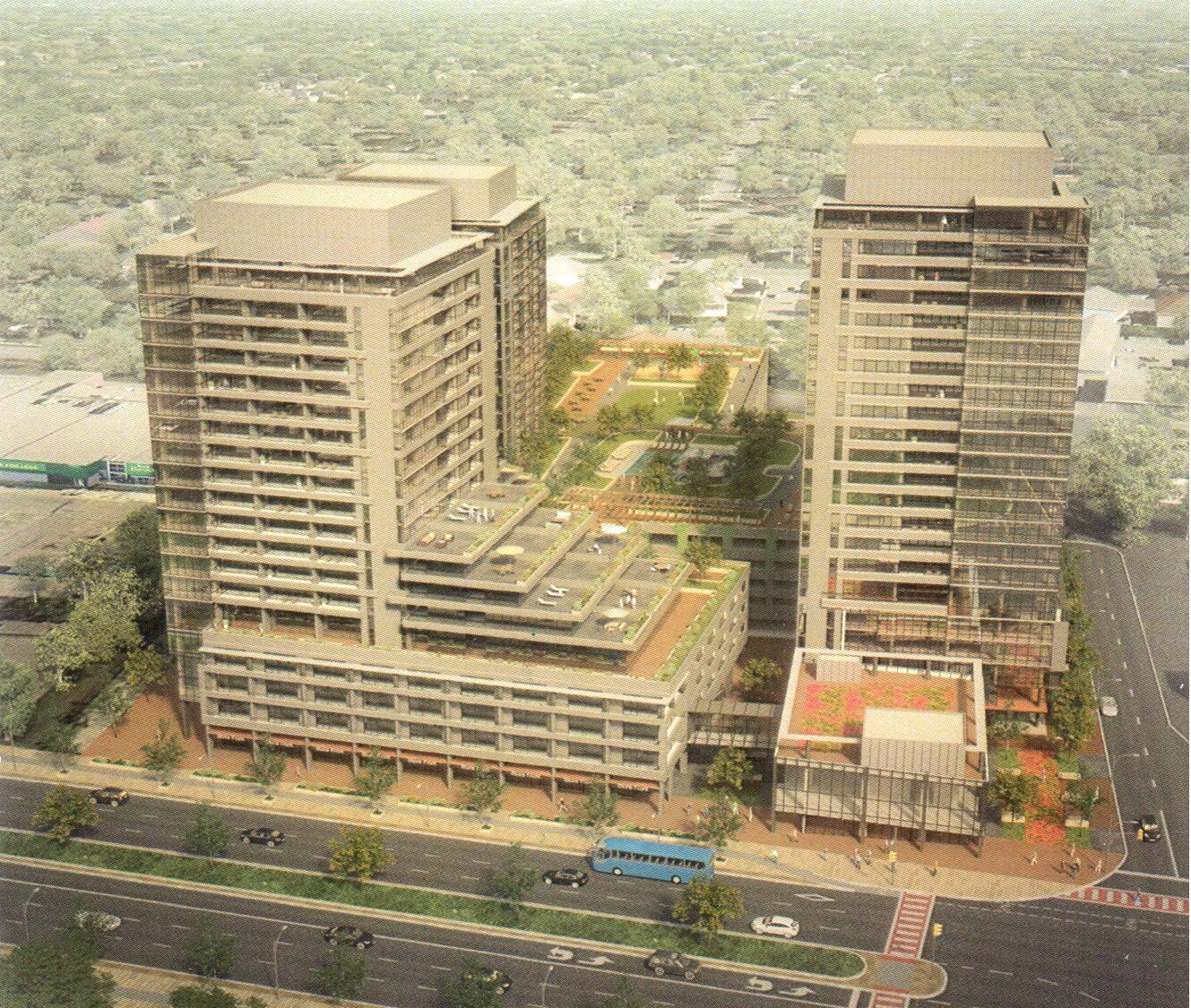
Does this mean everyone is deliriously happy with it? Probably not.
This major development will have 527 rental apartments in three residential towers, to be built sequentially in three phases over, perhaps, ten years. There are no plans for any of the apartments to be marketed as "affordable" using the affordability figure published annually by York Region. In 2016 it stood at $1,496 per month.
The Town's Secondary Plan reflects regional policy by stipulating that a minimum of 35% of new housing units in the Urban Centre (which includes 17645 Yonge Street) shall be affordable to low and moderate income households.
The report from the planning staff says:
"This 35% is not intended to be achieved on each individual application but rather within the Provincial Urban Growth Centre as a whole."
This is a good example of the planners kicking the can down the road, leaving it to another day, rather than confronting the issue now.
Conversations about affordability
Jane Twinney is the first councillor to ask about affordable housing. Is that part of the development? The Director of Planning, Rick Nethery, predictably reminds everyone that the 35% doesn't apply to individual developments.
"We have been having general conversations with the applicant. It is worth noting that the Secondary Plan speaks to a 35% affordable housing target - not for specific properties but for the whole Provincial Urban Growth Centre. So far, based on the information we have received from the applicant, there hasn't been an awful lot that speaks directly to that but we have the opportunity to have the conversation and whether or not there is any additional information they might be able to share with that. I don't know if Brad has anything to say."
This allows the developer's planning consultant, Brad Rogers, the man who is absolutely everywhere, to remind us the development will take ten years to complete.
So what? Does it have an affordable housing component or not?
Brad says he is happy to have conversations. He tells Twinney:
"It is about a ten year build out for all three phases so it will take at least two years to build the first building and so this transition of the property, it is not going to happen overnight. It is going to take a lot of time."
"And with respect to affordability and the rental component at this point we don't know what the rental rates are but we are happy to have these conversations with the Region of York and these types with respect to affordability."
Now Taylor wants to get into the conversation too:
"A development of this magnitude, if it doesn't help address the affordable housing issue in part then it puts quite a burden on some of the smaller developments that will subsequently come. So I hope this is a conversation we can continue to have and look at it."
Housing crisis
When they all get round to having their conversations I hope they will address a simple point that is staring everyone in the face. There is a housing crisis in Newmarket and across York Region. Put simply, spiralling house prices have put home ownership beyond the reach of too many people. And rents are way too high for too many people.
The Region polices the policy on affordability via annual reports showing progress against targets in the Region's 10-year Housing Plan. Here is the 2016 progress report on housing plan debated in June 2017
The Provincial Government says it is addressing the twin issues of getting housing to market faster and ensuring it is affordable. 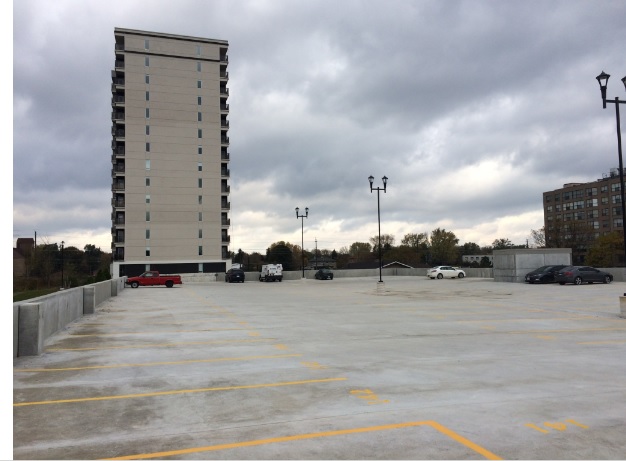
Here in Newmarket, 212 Davis Drive is being held up as a signature achievement in getting more rental accommodation actually built and occupied. Of course, to get this far, the Town had to make concessions to tempt the developer to go down the rental route but this is the world we live in.
Development charges were deferred and the Town allowed a huge slab of surface parking at 212 Davis Drive (see right) when its own Official Plan makes it clear:
"Parking areas should be located underground wherever possible in the Urban Centres."
Clearly, "wherever possible" is sufficiently elastic to allow surface parking if there are other competing policy imperatives. The huge Deerfield development next door to 212 Davis Drive and (beneficially) owned by the same Rose Corporation will be asking the Town in due course to give permission for a three storey above ground parking garage in the first phase, integrated into a four storey podium. Sounds a bit like Redwood.
In any event, surface parking, as the Rose Corporation's Sam Reisman will tell you, makes developments cheaper to build.
Inclusionary Zoning
In future, the Town may get round to triggering the powers municipalities have been given to force developers to include affordable housing in their developments through inclusionary zoning.
But for many people, including professional planners whose close symbiotic relationship with developers is a simple fact of life, that may be a step too far.
This email address is being protected from spambots. You need JavaScript enabled to view it.
- Details
- Written by Gordon Prentice
Back Story: Metrolinx is in the middle of a big consultation on its 2041 Draft Transportation Plan. Newmarket is hosting a public meeting for the York Region area and last night I wander along to the Community Centre at Doug Duncan Drive to see what's what.
Metrolinx staff are there in huge numbers. There are top policy makers and blue sky thinkers but fewer members of the public than I hoped to see. To compensate, I spot our Mayor, Tony Van Trappist, at the far end of the room. I hope to hear his views on the big transit and planning issues.
His default position is to say next to nothing, adopting a "I'm here to listen" pose, but I hope to flush him out on at least one or two issues. I see a vacant place at the Mayor's table and I bag it. He greets me enthusiastically. (I made that up.) 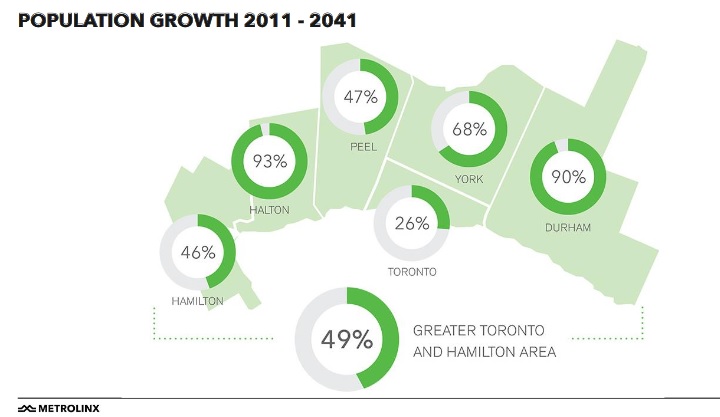
In the room next door there are a hundred seniors getting some kind of briefing on financial strategies in retirement. As the evening progresses they get more and more excitable. They force our key presenter, Lisa Salsberg, to use the microphone she had abandoned earlier as a way of making the evening more conversational. As Manager of Systems Planning and Strategic Policy she is one of Metrolinx's top movers and shakers.
Population Growth
She has a difficult job. Metrolinx has to deal with four levels of government and 30 municipalities - each with its own agenda. But they all face an explosive growth in population over the next 25 years. How will people move about in future without facing massive gridlock and congestion?
Ms Salsberg does the impossible, condensing the Draft Transportation Plan into easily digested bite-sized pieces which we are invited to consider in our round table discussions.
It is fascinating stuff. I hear about the future of transportation and autonomous vehicles but I don't want to go down that road. I am less interested in crystal ball gazing than in addressing the practical issues facing us here and now in Newmarket - such as no grade separation on Davis Drive. This puts the kybosh on a 15 minute GO Rail service from the Tannery.
15 minute service to Mulock
There is no way the Provincial Government is going to allow a huge chunk of the recently completed Davis Drive Rapidway to be ripped up to accommodate an underpass or an overpass. Just think of the optics! The Mayor breezily suggests an alternative. The 15 minute service could be extended up to Mulock where there will have to be grade separation. I am left wondering what the impact would be on the Tannery.
And John Taylor will be musing again on the interplay between both rail stations and the GO bus station on Eagle.
Now we are talking about the so-called "first and last mile". How do people get to the bus or rail station without using their cars? They can walk if it's not too far but what are the other options?
In the distant past when he was a simple banker and before he became famous the Mayor used to live in Pickering. He speaks lyrically of its Dial-a-Ride service where little buses, each dedicated to one of the six zones in the Town, would ferry travellers from the station to their homes, or close by.
I get the feeling the Mayor has been talking about Pickering for years, holding it up as an example of something which could be done and should be done but, for one reason or another, isn't being done. At least, not widely.
Land banking
One of the things Lisa Salsberg mentions in her tour d'horizon earlier is the need for better integration between transportation and land use planning. This gives me the perfect opening to lambast developers like Peter Czapka who buy land in strategic locations, get planning permission and then sit on it for years, choosing not to develop and waiting for land values to soar.
This happened with 22 George Street where planning approval was given in 1993 for a twelve storey, 115 unit condo. In 2009 approval was given for a twenty storey 280 unit condo at 39 Davis Drive. Scandalously, neither has been acted upon. The answer is to have planning permissions which lapse after, say, five years if work hasn't started on site.
Van Trappist stuns me by agreeing something should be done but says it would require legislation. And that, of course, is not his responsibility. He is asked if he has raised the issue at AMO - the Association of Municipalities of Ontario. The mumbled reply suggests he hasn't. 
Now each of the round tables is reporting back to the full meeting.
As the rapporteur at the table next to ours is making a series of very interesting points I notice Van Trappist is, yet again, glued to his iphone, face six inches from the screen.
Respect
There was a time when he considered such behaviour disrespectful because it indicated you were not listening to what was being said.
This is just the kind of inattention that gets him into trouble at York Regional Council.
This email address is being protected from spambots. You need JavaScript enabled to view it.
Metrolinx will be posting a report on the consultation meetings on its website in due course.
- Details
- Written by Gordon Prentice
Back Story: In 2008 Metrolinx published "The Big Move" - a visionary transportation plan designed to get the Region moving. It looked forward to 2031.
Metrolinx is now consulting the public on its update, the 2041 Regional Transportation Plan. Despite its length, it is packed full of graphics and colourful photos and makes for easy reading. However, it leaves answers to simple questions up in the air, unaddressed. 
A Place to Grow
Newmarket, a designated Place to Grow, may have to wait a quarter of a century before getting a 15 minute Go Rail service which our neighbour to the south, Aurora, will enjoy within the decade. The 15 minute all-day, two-way service from Toronto to Aurora will be up and running by 2025 at the latest.
We learn that the "15 minute GO Rail service extension" on the Barrie line from Aurora GO to East Gwillimbury GO Rail Station is "proposed" - but that's all we are told.
Projects in delivery, in development and proposed
The appendices (see below) list projects in delivery, in development or simply proposed but there is nothing in the body of the Draft Plan to indicate when the proposed projects will actually materialise. There are caveats and health warnings about future funding and future uncertainty but nothing is pencilled in to indicate the year or even the decade when Newmarket might get its 15 minute all-day two way-service.
This is hugely significant. If we have to wait until 2041 development along Davis Drive will undoubtedly be affected. A 15 minute service is impossible without grade separation at Davis Drive. If the road cannot go over the rail track (because of ground conditions) can the rail track go over the road? This astute question was posed by Ward 4 councillor, Tom Hempen, at the Town's Committee of the Whole last month but he didn't get an answer.
Grade Separation is key
The Town already has its Urban Centres Secondary Plan in place forecasting the future arrival of 32,000 people in the Yonge-Davis corridors at "build-out". Is this remotely realistic if we haven't sorted out the grade separation issue? And, by the way, when is build-out expected?
When the 2041 Draft Plan was considered by York Region's Committee of the Whole on 2 November 2017, the absence of a timeline was immediately spotted by Markham's Regional Councillor, the diligent Jack Heath. He was concerned about the absence of a date for completing the Yonge Subway Extension and says he wants it opened on a specified date, say 2031.
He calls for - and gets - the support of his colleagues. He says they should tell Metrolinx:
"This is the kind of time-frame York Region is thinking of. You (Metrolinx) come back and show us how it can be done."
Straight talking
This is an example of the kind of no-nonsense straight-talking that should have been employed with Newmarket's 15 minute service. In a debate where a number of members speak (Jones, Heath, Taylor, Spatafora, Rosati and Dawe) Van Trappist's lips are zipped.
John Taylor outlines his concerns. He tells us he hasn't seen a lot of thought or interplay go into the relationship between GO Bus and GO Rail in Newmarket. He goes further and says it seems very little thought has been given to Mulock (the proposed new GO Rail Station).
Mary Frances, the President of York Region Rapid Transit Corporation, tells him work is underway and
"You will be involved."
Oh dear!
The problem here is that Taylor is supposedly already centrally involved. He is a member of Metrolinx Barrie Regional Express Corridor Committee so if he doesn't know what is going on, then what hope for the rest of us?
This email address is being protected from spambots. You need JavaScript enabled to view it.
Correction on 7 November 2017: John Taylor has been in touch to say I may have misquoted him. He writes:
"My memory of what I said was that there seems to be very little thought given to the interplay between the existing Newmarket Station, the proposed Mulock Station and the existing GO Bus Station. I do not believe I said (and certainly did not intend to say) that no thought had been given to the Mulock Station (period). I am satisfied at this point that the planning for the Mulock Station is appropriately advanced for where it currently is in the planning process and the timeline ahead. However, I would like to see more detail or thought given to the interplay between the three stations."
Taylor is correct. I've checked my notes. As he spoke to the Regional Committee of the Whole I wrote: "Taylor wants more thought on interplay between the 3."
Draft Transportation Plan - appendices
Appendix 3B of the Draft Plan lists the "projects in delivery". These include:
* the Barrie line 15 minute GO Rail service from Union Station to Aurora GO
* the Barrie line all-day GO Rail service from Aurora GO to Barrie's Allandale Waterfront GO (half hour service in peak periods then hourly in the evenings and at weekends).
* Yonge Bus Rapid Transit (BRT) from Mulock Drive to Davis Drive. (With BRT buses have their own exclusive right of way, fully separated from other traffic.)
Appendix 3C shows projects in development including the Yonge Bus Rapid Transit (Richmond Hill, Aurora, Newmarket - 19th Ave to Mulock Drive.
Appendix 3D lists other projects proposed in the Draft 2041 Plan including
* the Barrie line 15 minute GO Rail service extension from Aurora GO to East Gwillimbury GO Rail Station.
* the Green Lane Priority Bus (Davis Drive to East Gwillimbury GO). (Priority bus services run fully or partially in a semi-exclusive right of way - a lower order than BRT.)
Consultation meeting
Metrolinx is hosting a public consultation session on the Draft 2041 Regional Transportation Plan from 6.30pm - 9pm on Wednesday 8 November 2017 at the Newmarket Community Centre, Doug Duncan Drive.
- Details
- Written by Gordon Prentice
Newmarket is represented on York Regional Council by the Mayor, Tony Van Trappist, and Regional Councillor John Taylor. 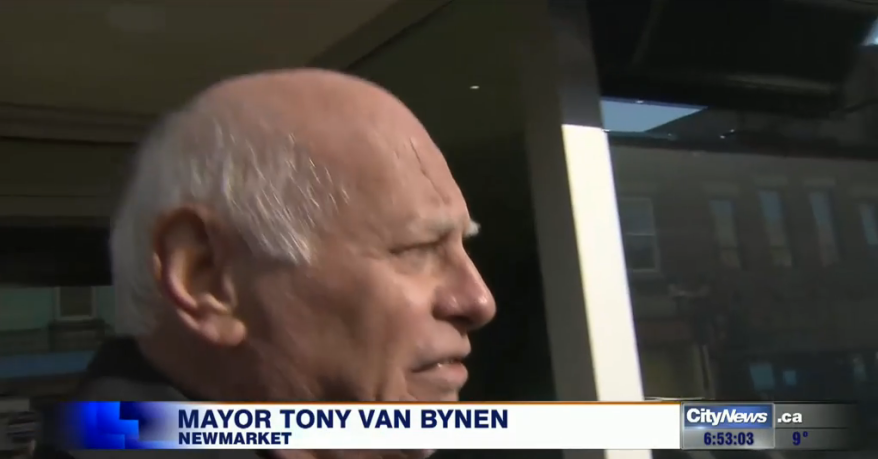
I don't always agree with Taylor but at least he consistently makes an effort to engage in the debate. By contrast, Van Trappist, hunched over and deep in his own thoughts, rarely seeks to intervene. For the most part, he is a gawping spectator at events.
Fortunately, as from 1 January 2018, Newmarket Council will have new powers to appoint a named substitute or "alternate" for the Mayor when, for whatever reason, he chooses not to attend.
Lassitude and torpor
If he stays away this will have a number of positive benefits. The substitute will bring fresh energy to the Regional Council chamber, replacing the lassitude and torpor we have come to associate with Van Trappist. The substitute is also likely to report back to Newmarket Council - something that happens now but only in a very perfunctory way. A short written report would be a major step forward.
With my proposal, Van Trappist would keep the $68,194.33 in "stipend" and other benefits and expenses he gets from York Region. We do not want him to feel short-changed. In any event, he deserves proper compensation for his work on the York Region Data Consortium and the Community Partnership Council. And he also chairs a "Broadband Strategy Advisory Task Force" which was established a few years ago to:
"support staff in advancing the goals of the York Region Broadband Strategy".
York Telecom Network 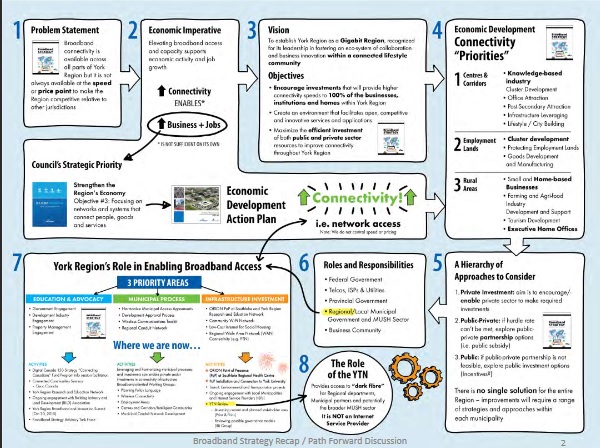
Earlier this month (12 October 2017), the Region's Committee of the Whole had a report before it recommending the setting up of the York Telecom Network - a York Region owned entity with a Board of Directors. It will be up and running on 1 January 2018. Is this a big deal or not?
The report says:
"The fibre network owned by the Region has the potential to have positive economic and community impact beyond addressing the Region's information technology needs. Through incorporating a separate entity "YTN Telecom Network Inc" the Region can optimise these benefits by making the network more accessible and nimble."
Isn't this worth a word or two from Van Trappist? After all, he's on the new Board.
The sound of silence
Aurora Mayor, Geoff Dawe, who is in the Chair for this part of the proceedings, asks if anyone wants to comment. Here is Van Trappist's chance to shine. Broadband is supposedly his big thing. There is a long pause as we wait for someone to say something. Silence. Van Trappist moves the report be received.
And, without missing a beat, they move on to the next item of business.
A member of the public sitting in the row in front of me gets up to go. He turns and says with a broad smile:
"Did Tony fall asleep over there?"
gordon.prentice@shrinkslessor square.ca
Update on 30 October 2017: This post has been amended to correct an earlier inaccuracy. Tony Van Bynen does not serve on the Audit Committee. Van Bynen also occupies a seat on the York Region Rapid Transit Corporation.
Page 162 of 286